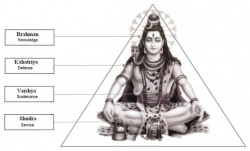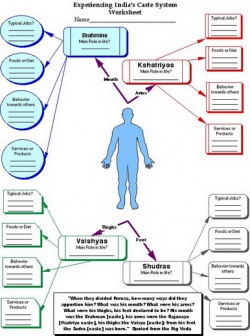Difference between revisions of "Four Indian castes"
m (Text replacement - "The Buddha" to "The Buddha") |
|||
| Line 7: | Line 7: | ||
(4) śūdra (serf). | (4) śūdra (serf). | ||
| − | [[ | + | The [[Buddha]] ruled that all from the four castes would be allowed to become Buddhist śramaṇas as the fifth [[Caste]], the highest of all castes. |
The Indian [[Caste]] system is the traditional organization of South Asian, particularly Hindu, society into a hierarchy of hereditary groups called castes or jatis. In broad outline, marriage occurs only within [[Caste]] (endogamy), [[Caste]] is fixed by birth, and each [[Caste]] is associated with a traditional occupation, such as weaving or barbering. Hindu religious principles underlay the [[Caste]] hierarchy and limit the ways that castes can interact. | The Indian [[Caste]] system is the traditional organization of South Asian, particularly Hindu, society into a hierarchy of hereditary groups called castes or jatis. In broad outline, marriage occurs only within [[Caste]] (endogamy), [[Caste]] is fixed by birth, and each [[Caste]] is associated with a traditional occupation, such as weaving or barbering. Hindu religious principles underlay the [[Caste]] hierarchy and limit the ways that castes can interact. | ||
Revision as of 16:57, 12 September 2013
four Indian castes (四姓). These are
(1) Brahmin (priest),
(2) Kṣatriya (royalty and warrior),
(3) vaiśya (farmer and merchant), and
(4) śūdra (serf).
The Buddha ruled that all from the four castes would be allowed to become Buddhist śramaṇas as the fifth Caste, the highest of all castes.
The Indian Caste system is the traditional organization of South Asian, particularly Hindu, society into a hierarchy of hereditary groups called castes or jatis. In broad outline, marriage occurs only within Caste (endogamy), Caste is fixed by birth, and each Caste is associated with a traditional occupation, such as weaving or barbering. Hindu religious principles underlay the Caste hierarchy and limit the ways that castes can interact.
The Caste system is connected to the Hindu concept of the four varnas, which order and rank humanity by innate Spiritual purity. The highest Varna is the Brahmins, or priests. Next comes the Kshatriyas, the warriors, and then the Vaishyas, the merchants. The lowest Varna is the Shudras, consisting of labourers, artisans and servants who do work that is ritually unclean. Contact between varnas, and particularly the sharing of Food and water, must be limited to avoid pollution of higher, purer individuals by lower, more unclean ones.
In practice, the Caste system consists of thousands of jatis, generally of a local or regional nature. Each has its own history, customs, and claimed descent from one of the four varnas. Members of a Jati may have many different professions, although commonly they will be related in status and nature to the Jati's traditional occupation. Wealth and Power generally rise with Caste status, but individuals may be rich or poor. Subgroups within a Jati may practice hypergamy or exogamy. There is no official or universal ranking that determines the Caste hierarchy. Precedence depends on the local community's estimation of a Jati's secular importance and Ritual purity, and is therefore somewhat fluid. A Jati can increase its status by growing in size, Wealth and Power, by avoiding low or unclean work, and by adopting priestly ways, such as Vegetarianism and teetotalism, a process called sanskritization. Generally, however, Brahmins are the highest Caste, and at the bottom of society are those associated with occupations considered extremely unclean, such as handling garbage, excrement, or corpses. In the past these castes were called untouchables, because their touch polluted. They were often forbidden from entering temples, living inside the village, drinking from wells used by high castes, or even letting their shadows fall on a Brahmin.
As India approached independence from British rule in the early 20th century, the Caste system was increasingly criticized as a discriminatory and unjust system of social stratification, especially in regard to the impoverished untouchables. Two great figures of independence, B. R. Ambedkar and Mahatma Gandhi, led major reform movements, although they proposed radically different solutions. The current Indian constitution bans discrimination on the basis of Caste and use of the term "untouchable", and the Indian government has instituted affirmative action programs for those who have become known as the Dalits, or "crushed peoples". Individual Dalits have achieved great political and financial success, but as a group they still complain of sometimes violent discrimination. The growth of Information-age India has reduced the economic importance of the Caste system, but its social and religious aspects remain a significant and sometimes divisive part of Indian Life.
When Ywan Chwang traveled to South India after the period of the Chalukyan Empire, he noticed that the Caste system had existed among the Buddhists and Jains.
Buddhism in India, like other religions, has attempted to reform and create a society without classes. Nevertheless, in some parts of India such a Ladakh, with significant historical presence of Buddhists, a Caste system existed in a manner similar to Caste structure in Tibet. The upper castes belonged to sger gzhis, and were called sgar pa. The priestly Caste belonged to Monastery, and were called chos-gzhis. Miser were the serf Caste. Serfs, the majority of the people, farmed and paid taxes. An individual's social status and lifelong occupation was destined by birth, closed, and depending on the family one was born into, the individual inherited a tenure document known as khral-rten. Buddhist castes had sub-castes, such as nang gzan, khral pa and dud chung. Buddhist also had castes that were shunned by their community and ostracized, such as hereditary fishermen, butchers and undertakers. The untouchables in Buddhist regions, as in Tibet, were known as Ragyappa, who lived in isolated ghettos, and their occupation was to remove corpses (human or animal) and dispose of sewage.

